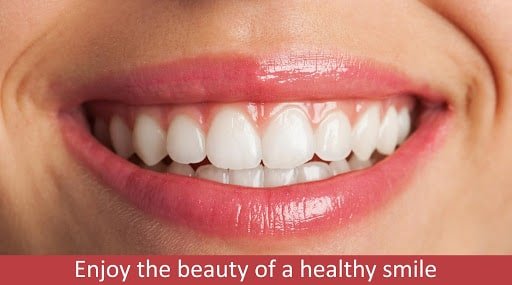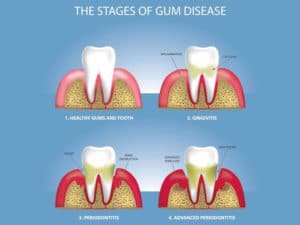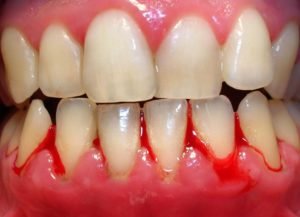Periodontal disease, also known as gum disease, is a bacterial infection of the gums and tissues that support your teeth. It is caused most often by the build-up of plaque and tartar when teeth are not routinely brushed and flossed. Periodontal disease is a major cause of teeth/implant loss.
Gum Treatments
What is Gum Treatments?

Gingivitis:
- The earlier stage, gingivitis, is a mild form of gum disease caused by plaque build-up around the gum line which causes inflammation of the gums. If you neglect to brush or floss your teeth daily, this plaque build-up will trap bacteria and cause gum disease. Your gums will appear red and swollen, and you could experience bleeding when you brush or floss. If properly treated, it may be reversed.
Periodontitis:
- Left untreated, gingivitis turns into periodontitis during this more destructive disease stage, the supporting bones and fibers that hold your teeth in place have been irreversibly damaged, as bacteria penetrate the deeper pockets of tissue. Immediate treatment is necessary to prevent further damage and tooth loss.Both gingivitis and periodontitis have been shown to raise your risk of things like diabetes, heart disease, osteoporosis, pneumonia, and cancer. Without regular dental check-ups, you won’t know that you have gum disease until your condition is in its advanced stages.

Treatments for gum disease can vary depending on the severity of each individual case. Typical treatments include:
-
- Non-surgical treatments
- Scaling & root planning (deep cleaning)

- The early stages of gum disease may only require non-surgical treatment like scaling and root planning, a minor procedure involves careful removal of plaque and tartar from the affected gums, and smooth the tooth root to remove any bacterial toxins.
-
- Flap surgery/pocket reduction surgery. During this procedure, the gums are lifted back and the tartar is removed. In some cases, irregular surfaces of the damaged bone are smoothed to limit areas where disease-causing bacteria can hide. The gums are then placed so that the tissue fits snugly around the tooth. This method reduces the size of the space between the gum and tooth, thereby decreasing the areas where harmful bacteria can grow and decreasing the chance of serious health problems associated with periodontal disease.
- Bone Grafts. This procedure involves using fragments of your own bone, synthetic bone, or donated bone to replace bone destroyed by gum disease. The grafts serve as a platform for the regrowth of bone, which restores stability to teeth. New technology, called tissue engineering, encourages your own body to regenerate bone and tissue at an accelerated rate.
- Soft tissue grafts. This procedure reinforces thin gums or fills in places where gums have receded. Grafted tissue, most often taken from the roof of the mouth, is stitched in place, adding tissue to the affected area.
- Guided tissue regeneration. Performed when the bone supporting your teeth has been destroyed, this procedure stimulates bone and gum tissue growth. Done in combination with flap surgery, a small piece of mesh-like fabric is inserted between the bone and gum tissue. This keeps the gum tissue from growing into the area where the bone should be, allowing the bone and connective tissue to regrow to better support the teeth.
- Bone surgery. Smooth’s shallow craters in the bone due to moderate and advanced bone loss. Following flap surgery, the bone around the tooth is reshaped to decrease the craters. This makes it harder for bacteria to collect and grow.
Frequently Asked Questions
What are the symptoms of gum disease?
Symptoms of gum disease can include bleeding gums, receding gums, bad breath, and drifting teeth.
What Causes Gum Disease?
Causes include smoking and poor dental hygiene. There are also risk factors you might not be able to control, such as genetics, age and underlying diseases like diabetes or heart disease.
What Are the Dangers of Gum Disease?
Periodontitis can cause tooth loss and serious infections. In rare cases, the infection can spread. There are also indications that dental infections can cause heart problems or exacerbate the symptoms of diabetes.
How gum disease is linked with other health conditions?
In recent years gum disease has been linked with general health conditions such as diabetes, strokes, cardiovascular disease, poor pregnancy outcomes, and even dementia. More research is needed to understand how these links work but there is more and more evidence that having a healthy mouth and gums can help improve your general health and reduce the costs of medical treatment.
What is the difference between plaque and calculus?
Plaque is the sticky, colourless film that constantly forms on your teeth. Bacteria live in plaque and secrete acids that cause tooth decay and irritate gum tissue. This irritation causes an inflammatory reaction by your body that can eventually lead to gingivitis and periodontal disease. If plaque is not removed regularly by tooth brushing and flossing, it hardens to create calculus (also known as tartar). Calculus cannot be removed with a toothbrush; only a dental professional can remove it during an oral cleaning. To keep plaque and calculus under control, it is essential to brush your teeth twice every day, floss at least once every day, and see your dental professional for regular cleanings.
Can children be at risk for developing the periodontal disease?
Periodontal disease is rarely found in children, and only sometimes found in adolescents. However, children should still learn the importance of keeping their teeth and gums healthy to prevent periodontal disease in the future. Children should brush their teeth twice a day and learn how to floss properly- if children learn how to floss at an early age, they will be more likely to make it a lifetime habit. These two simple acts will help protect their teeth and gums from periodontal disease.
What can I do at home to prevent periodontal disease?
The best way to prevent periodontal disease is to take good care of your teeth and gums at home. This includes brushing your teeth after every meal and before bedtime, flossing at least once each day, and seeing your dentist for regular exams twice a year. Spending a few minutes a day on preventative measures may save you the time and money of treating periodontal disease!
Both of my parents have periodontal disease, and I'm worried that it may be genetic. Is there a way to determine my risk for developing gum disease?
Recent research has shown that genetics may be involved in a person’s risk for gum disease, but there are a variety of other factors that also play a role.
Is periodontal disease contagious?
Research has shown that periodontal disease is caused by the inflammatory reaction to bacteria under the gums, so periodontal disease technically may not be contagious. However, the bacteria that cause the inflammatory reaction can be spread through saliva. This means that if one of your family members has periodontal disease, it’s a good idea to avoid contact with their saliva by not sharing eating utensils or oral health equipment. If you notice that your spouse or a family member has the warning signs of a possible periodontal problem (bleeding, red and swollen gums, or bad breath) you may want to suggest that they see the dentist for an examination.
Why Are My Gums Bleeding?
As we age, it’s increasingly common to see a drop or two of blood in the sink after brushing or flossing. They’re a sign possibly along with other often-missed red alerts like puffy, red, irritated gums of gingivitis (early gum disease). Millions of adults have some form of gum disease, yet only a very small fraction realize it because gum pain is not an early symptom. Early-stage gum disease is reversible, through improved daily mouth care and more frequent visits to the dentist for plaque and tartar removal with professional tools. But left ignored, blood in the sink can progress to serious gum disease (periodontitis) that attacks gums, erodes the jawbone and is the number-one reason teeth fall out. If you’ve spotted droplets, don’t wait another day to start improving your brush, floss and rinse routine.
What kind of recovery time can I expect after periodontal treatment?
We encourage you to follow the post-op instructions you are given. Most patients begin to feel better after the first day. However, each recovery depends on the procedure, as some procedures are more invasive and will require longer recovery time.
How will smoking affect my gums and teeth?
Smoking can also make gum disease worse. People who smoke are more likely to produce bacterial plaque, which leads to gum disease. The gums are affected because smoking causes a lack of oxygen in the bloodstream, so the infected gums don’t heal. Smoking causes people to have more plaque and gum disease to get worse more quickly than in non-smokers. Gum disease is still a major cause of tooth loss in adults.
What happens if gum disease is not treated?
Unfortunately, gum disease does not usually cause pain as it gets worse so you do not notice the damage it is doing. However, the bacteria are sometimes more active and this makes your gums sore. This can lead to gum abscesses, and pus may ooze from around the teeth. Over a number of years, the bone supporting the teeth can be lost. If the disease is left untreated for a long time, treatment can be more difficult.

